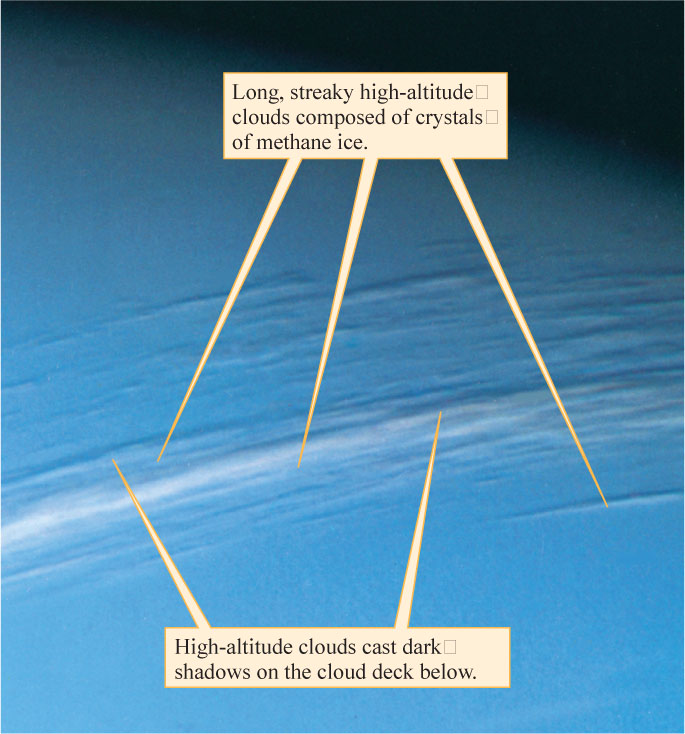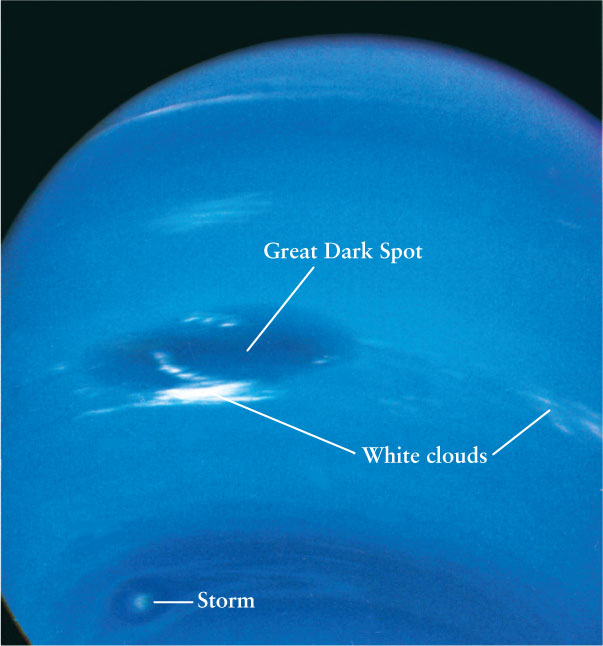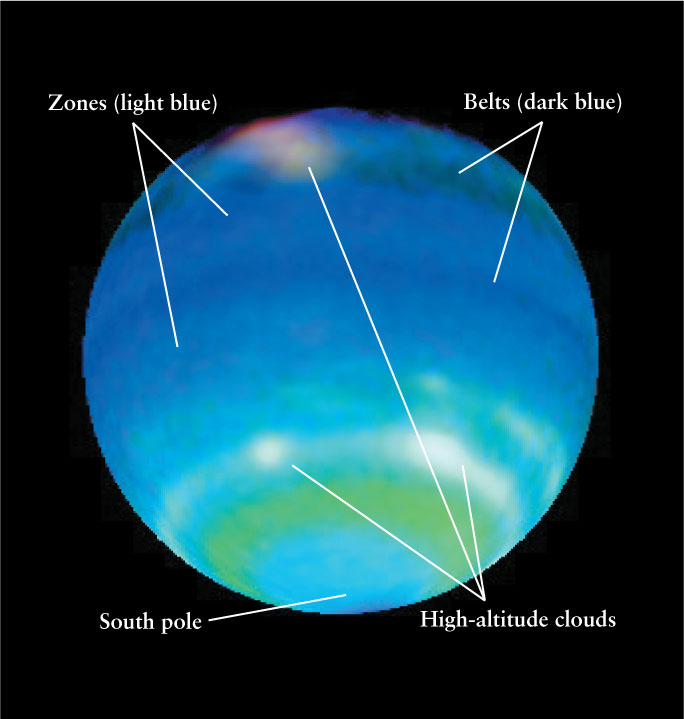14-3 Neptune is a cold, bluish world with Jupiterlike atmospheric features
 At first glance, Neptune appears to be the twin of Uranus. (See the image that opens this chapter, and compare Table 14-1 and Table 14-2.) But these two planets are by no means identical. While Neptune and Uranus have almost the same diameter, Neptune is 18% more massive. Neptune’s axis of rotation also has a more modest 29½° tilt. When Voyager 2 flew past Neptune in August 1989, it revealed that the planet has a more active and dynamic atmosphere than Uranus. This activity suggests that Neptune, unlike Uranus, has a powerful source of energy in its interior.
At first glance, Neptune appears to be the twin of Uranus. (See the image that opens this chapter, and compare Table 14-1 and Table 14-2.) But these two planets are by no means identical. While Neptune and Uranus have almost the same diameter, Neptune is 18% more massive. Neptune’s axis of rotation also has a more modest 29½° tilt. When Voyager 2 flew past Neptune in August 1989, it revealed that the planet has a more active and dynamic atmosphere than Uranus. This activity suggests that Neptune, unlike Uranus, has a powerful source of energy in its interior.
Neptune’s Atmosphere
Unlike its close relative Uranus, Neptune has truly immense storms
The Voyager 2 data showed that Neptune has essentially the same atmospheric composition as Uranus: 79% hydrogen, 18% helium, 3% methane, and almost no ammonia or water vapor. As for Uranus, the presence of methane gives Neptune a characteristic bluish-green color. The temperature in the upper atmosphere is also the same as on Uranus, about 55 K. That these temperatures should be so similar, even though Neptune is much farther from the Sun, is further evidence that Neptune has a strong internal heat source.
Unlike Uranus, however, Neptune has clearly visible cloud patterns in its atmosphere. At the time that Voyager 2 flew past Neptune, the most prominent feature in the planet’s atmosphere was a giant storm called the Great Dark Spot (Figure 14-4). The Great Dark Spot had a number of similarities to Jupiter’s Great Red Spot (see Section 12-1 and Section 12-3). The storms on both planets were comparable in size to Earth’s diameter, both appeared at about the same latitude in the southern hemisphere, and the winds in both storms circulated in a counterclockwise direction (see Figure 12-5). But Neptune’s Great Dark Spot appears not to have been as long-lived as the Great Red Spot on Jupiter. When the Hubble Space Telescope first viewed Neptune in 1994, the Great Dark Spot had disappeared.

Cirrus Clouds over Neptune Voyager 2 recorded this image of clouds near Neptune’s terminator (the border between day and night on the planet). Like wispy, high-altitude cirrus clouds in Earth’s atmosphere, these clouds are thought to be made of ice crystals. The difference is that Neptune’s cirrus clouds are probably methane-ice, not water-ice as on Earth.

 R I V U X G
R I V U X GNeptune from Voyager 2 When this picture of Neptune’s southern hemisphere was taken in 1989, the Great Dark Spot measured about 12,000 by 8000 km, comparable in size to Earth. (A smaller storm appears at the lower left.) The white clouds are thought to be composed of crystals of methane-ice. The color contrast in this image has been exaggerated to emphasize the differences between dark and light areas.
Voyager 2 also saw a few conspicuous whitish clouds on Neptune. These clouds are thought to be produced when winds carry methane gas into the cool, upper atmosphere, where it condenses into crystals of methane-ice. Voyager 2 images show these high-altitude clouds casting shadows onto lower levels of Neptune’s atmosphere (Figure 14-5). Images from the Hubble Space Telescope also show the presence of high-altitude clouds (Figure 14-6).

Neptune’s Banded Structure This enhanced-color Hubble Space Telescope image shows Neptune’s belts and zones. White areas denote high-altitude clouds; the very highest clouds (near the top of the image) are shown in yellow-red. The green belt near the south pole is a region where the atmosphere absorbs blue light, perhaps indicating a different chemical composition there.
Neptune’s Internal Heat
Due to its greater distance from the Sun, Neptune receives less than half as much energy from the Sun as Uranus. But with less solar energy available to power atmospheric motions, why are there high-altitude clouds and huge, dark storms on Neptune but not on Uranus? At least part of the answer is probably that Neptune is still slowly contracting, thus converting gravitational energy into thermal energy that heats the planet’s core. (The same is true for Jupiter and Saturn, as we saw in Section 12-4.) The evidence for this contraction is that Neptune, like Jupiter and Saturn but unlike Uranus, emits more energy than it receives from the Sun. The combination of a warm interior and a cold outer atmosphere can cause convection in Neptune’s atmosphere, producing the up-and-down motion of gases that generates clouds and storms. Neptune also resembles Jupiter in having faint belts and zones parallel to the planet’s equator (see Figure 14-6).
Like those on Uranus, most of Neptune’s clouds are probably made of droplets of liquid methane. Because these droplets form fairly deep within the atmosphere, the clouds are more difficult to see than the ones on Jupiter. Hence, Neptune’s belts and zones are less pronounced than Jupiter’s, although more so than those on Uranus (thanks to the extra cloud-building energy from Neptune’s interior). As described above, Neptune’s high-altitude clouds (see Figure 14-5) are probably made of frozen methane.
Although Neptune displays more evidence of up-and-down motion in its atmosphere than Uranus, the global pattern of east and west winds is almost identical on the two planets. This similarity is rather strange. The two planets are heated very differently by the Sun, thanks to their different distances from the Sun and the different tilts of their axes of rotation, so we might have expected the wind patterns on Uranus and Neptune also to be different. Perhaps the explanation of these wind patterns will involve understanding how heat is transported not only within the atmospheres of Uranus and Neptune but within their interiors as well.
CONCEPT CHECK 14-3
With Neptune even farther from the Sun than Uranus, where does Neptune get the energy to power more atmospheric activity than Uranus?
It is thought that Neptune is still contracting, which converts gravitational energy into thermal energy to power its atmosphere.